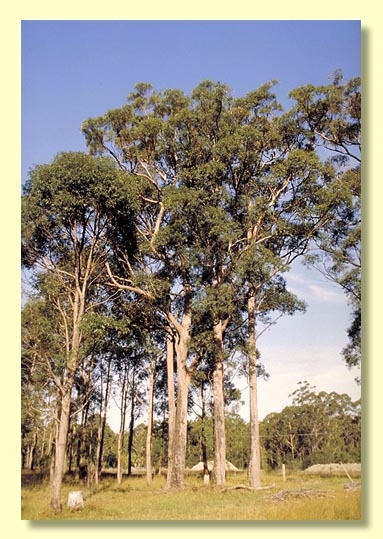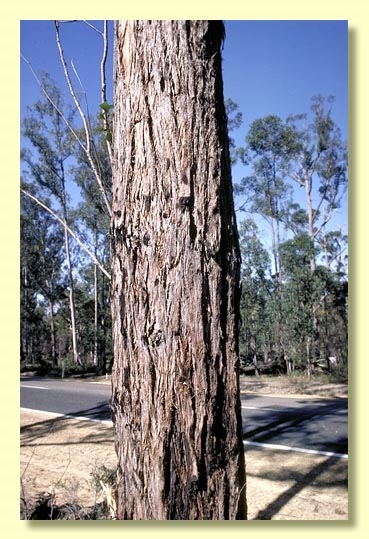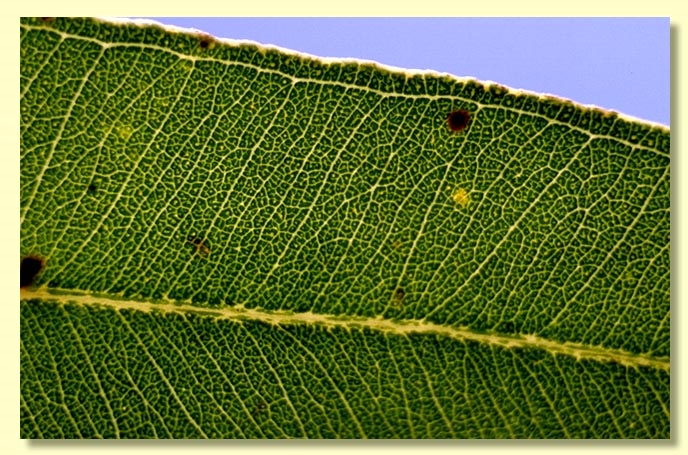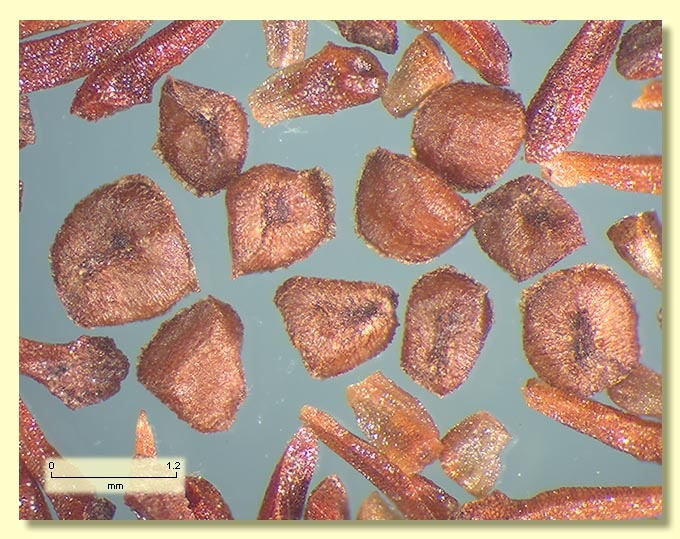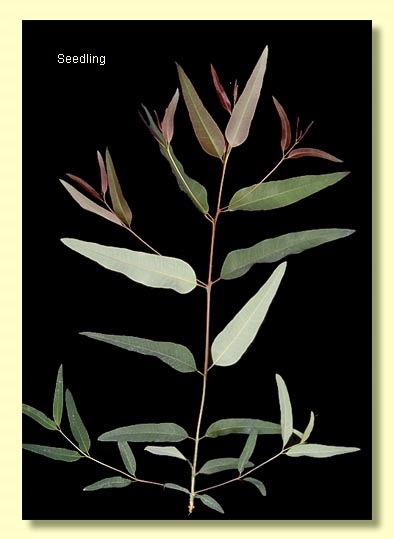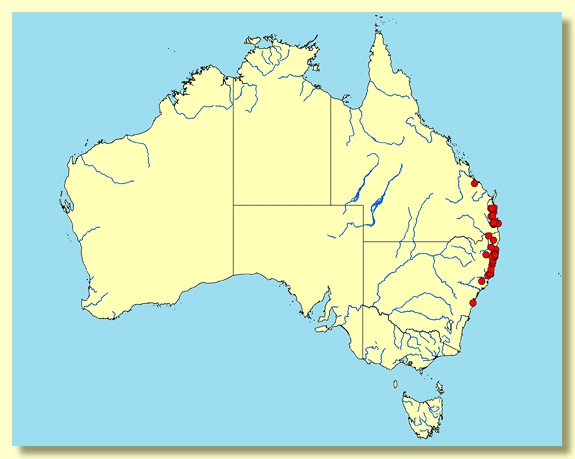Euclid - Online edition
Eucalyptus resinifera subsp. hemilampra
Eucalyptus | Symphyomyrtus | Latoangulatae | Annulares
Eucalyptus hemilampra F.Muell., J.Proc. Linn. Soc., Bot. 3: 85 (1859); E. resinifera var. hemilampra (F.Muell.) Domin, Biblioth. Bot. 89: 468 (1928). T: Queensland, Upper Brisbane River, F.Mueller s.n.; holo: MEL; iso: K, NSW
Bark rough to small branches, stringy or fibrous, grey or grey-brown, held in long, flat strips with shallow fissures in between.
Juvenile growth (coppice or field seedlings to 50 cm): stem rounded or square in cross-section; juvenile leaves always petiolate, opposite for 4 to 6 nodes then alternate, lanceolate, 6.5–15.5 cm long, 1.7–4 cm wide, base rounded or tapering to petiole, discolorous, dull, green.
Adult leaves alternate, petiole 1–2 cm long; blade lanceolate, 6–17 cm long, 1.3–3 cm wide, base tapering to petiole, apex tapering to a long fine point, discolorous, glossy, darker green above, paler below, strongly penniveined, densely to very densely reticulate, intramarginal vein parallel to and just within margin, oil glands island.
Inflorescence axillary unbranched, peduncles 0.7–2 cm long, buds 7, 9 or 11, pedicellate (pedicels 0.3–1.1 cm long). Mature buds ovoid to fusiform (1.4–1.9 cm long, 0.3–0.6 cm wide), yellow or creamy, scar present, operculum horn-shaped, > 0.9 cm long, stamens erect, anthers cuboid to oblong, versatile, dorsifixed, dehiscing by longitudinal slits (non-confluent), style long, stigma tapered, locules 3 or 4, the placentae each with 4 or 6 vertical ovule rows. Flowers white.
Fruit pedicellate (pedicels 0.3–1 cm long), hemispherical, obconical or cup-shaped, 0.3–0.7 cm long, 0.6–1 cm wide, disc raised-convex to annular, valves 3 or 4, strongly exserted.
Seeds brown, 1–2 mm long, pyramidal to cuboid, sometimes flattened, dorsal surface shallowly pitted to smooth, hilum ventral or terminal.
Cultivated seedlings (measured at ca node 10): cotyledons bilobed; stems square in cross-section; leaves always petiolate, opposite for 4 to 6 nodes then alternate, ovate-lanceolate, 7–15.5 cm long, 1.5–4 cm wide, base rounded to tapering, discolorous, dark green above, paler beneath.
Flowering time unknown.
Eucalyptus resinifera is a medium-sized to tall tree species of coastal eastern Australia occurring over a wide latitudinal range from Huskisson on Jervis Bay on the south coast of New South Wales north into Queensland almost to Gladstone, with further sporadic occurrences on the higher ground in the Nebo–Eungella region, the Mt Spec – Paluma region, the Atherton Tablelands and the Lankelly Creek – McIlwraith range region of Cape York. It is found on slopes and flats, often sheltered and wetter sites and in more northern occurrences even in rainforest. One of the red mahoganies, E. resinifera, shares the very thick, rough, fibrous bark, strongly discolorous leaves with wide-angled venation, and fruit with exserted valves.
Eucalyptus resinifera belongs in Eucalyptus subgenus Symphyomyrtus section Latoangulatae because cotyledons are bilobed, leaves are discolorous and have side-veins at a wide angle to the midrib, buds have two opercula and fruit have exserted valves. Within this section, E. resinifera is one of seven species forming series Annulares (the red mahoganies), as it has ovules in six or eight rows, seeds cuboid to pyramidal and bark rough over the trunk. The other six species are E. pellita, from coastal north Queensland and New Guinea; E. urophylla, from Timor and other islands to the north-west of Australia; E. scias, endemic to New South Wales from the coastal and subcoastal ranges, principally from Batemans Bay north to Cessnock with a disjunct occurence east of Tenterfield (subsp. apoda); E. notabilis, scattered in coastal and subcoastal New South Wales and south-eastern Queensland; E. robusta, widespread in coastal New South Wales and Queensland; and E. botryoides, from coastal eastern Victoria and southern New South Wales.
It differs from the closely related E. pellita, E. notabilis, E. scias and E. urophylla by the slender fusiform, distinctly pedicellate buds which have an acute operculum, where the base of the operculum is normally not wider than the hypanthium. (E. pellita, E. notabilis, E. scias and E. urophylla normally have fatter buds, where the base of the operculum is wider than the hypanthium.) E. robusta has larger buds and cylindrical fruit with valves remaining joined across the orifice. E. botryoides has sessile to shortly pedicellate oblong buds and cylindrical to barrel-shaped fruit.
There are two subspecies:
E. resinifera subsp. resinifera
Has a short, conical operculum, with the stamens regularly to irregularly flexed in the bud. Occurs in two disjunct regions, in coastal areas from Jervis Bay north to about Kempsey in New South Wales and then much further north into Queensland where it occurs on the higher ground in the Nebo–Eugella region, the Mt Spec – Paluma region, the Atherton Tablelands and the Lankelly Creek – McIlwraith range region of Cape York. (The northern populations were recently described by Hill & Johnson (2000) as E. macta. The authors of EUCLID can find no consistent substantial differences between the north Queensland and more southerly populations and have therefore relegated E. macta to synonymy with E. resinifera subsp. resinifera.)
E. resinifera subsp. hemilampra
Subsp. hemilampra has a long, much narrower operculum, with most of the stamens erect in the bud. Occurs from near Taree on the North Coast of New South Wales extending into Queensland, north to about Gladstone.
subsp. hemilampra: Greek hemi, half and lampra, shining, probably referring to the dorsiventral leaves.

